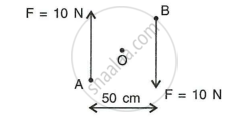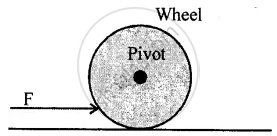Advertisements
Advertisements
Question
The figure shows two forces each of magnitude 10 N acting at the point A and B at a separation of 50 cm, in opposite directions. Calculate the resultant moment of two forces about the point.
- A,
- B and
- O situated exactly at the middle of the two forces.

Solution
Moments of force = Force × distance
F = 10 N at A and B
distance between them = 50 cm
= `50/100`
= 0.5 m
i. Moment of force at A = 10 × 0.5
= 5 N m (clockwise)
ii. Moment of force at B = 10 × 0.5
= 5 N m (clockwise)
iii. Moment of force at O = 2.5 + 2.5
= 5 N m (clockwise)
APPEARS IN
RELATED QUESTIONS
A force always produces both the linear and turning motions.
State the effect of force F in of the following diagram.

State the condition when the change in the momentum of a body depends only on the change in its velocity.
State Newton's third law of motion.
What do you understand by the clockwise and anticlockwise moment of force? When is it taken positive?
The diagram in the figure shows a uniform metre rule weighing 100 gf, pivoted as its centre O. two weight 150 gf and 250 gf hang from the point A and B respectively of the metre rule such that OA = 40 cm and OB = 20 cm . Calculate
the total anticlockwise moment about o.

How does the distance of separation between two bodies affect the magnitude of the non-contact force between them?
State two factors on which moment of the force about a point depends.
What is meant by the term ‘moment of force’? If the moment of force is assigned a negative sign then will the turning tendency of the force be clockwise or anti-clockwise?
A uniform metre rule rests horizontally on a knife-edge at the 60 cm mark when a mass of 10 gram is suspended from one end. At which end must this mass be suspended? What is the mass of the rule?
